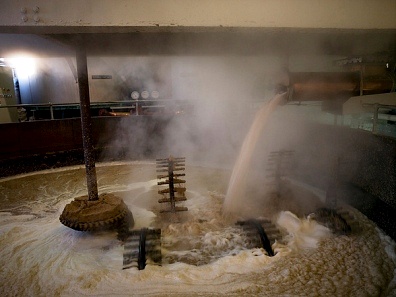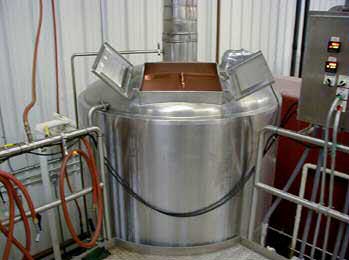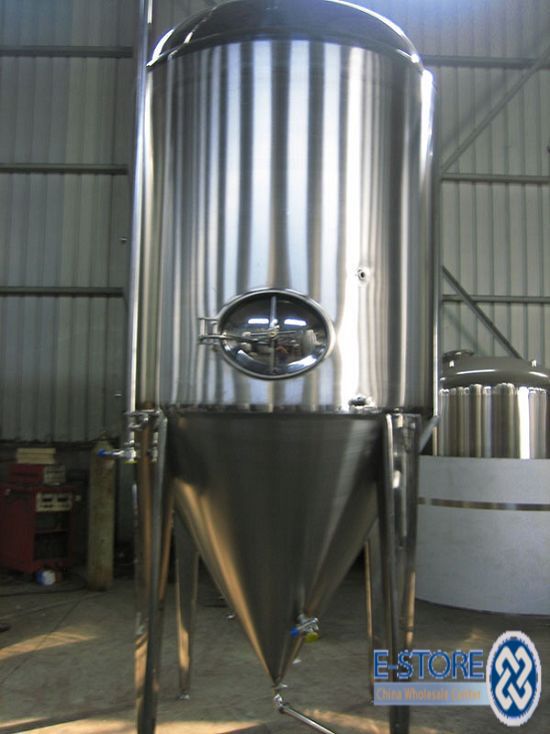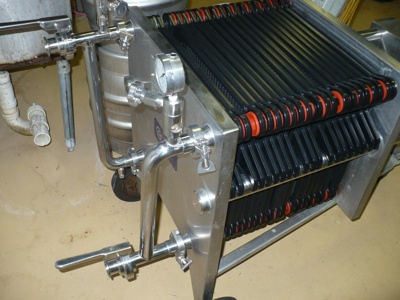Whether commercial or homebrewing, the basic process of making beer is pretty much the same. On a commercial system you'll likely have more control than you would have on a five gallon brew system in your garage, but the steps are similar.
Here are some of the steps in the brewing process to help you better understand how beer becomes beer. Why is one beer a different color, bitterness, sweetness, etc?
1. Planning. This seems pretty obvious but it takes careful planning and preparation to make a great beer. The most basic of planning involves deciding the style of beer you want to make. What color? How Bitter? What strain of yeast? Combining various malts of various colors will change the color of the finished beer as well as the flavor. All light malt will yield a light colored beer. Add dark malt and you will start to darken the final product. The quantity and intensity of the malt will determine color. Imagine mixing paint in art class. You start with a white base, then mix various colors to achieve the desired hue. Adding a little bit of black to a yellowish base will lend a amber, copper, or brownish color. Add a lot of black color to the mix and it will inevitably make it completely black. This, as I had mentioned, will affect beer flavor as well. Lighter grains may lend a general light, malty sweetness where amber or "crystal" malts will add a note of caramelly sweetness, while dark roasted malts in high quantities may offer a chocolate, coffee, or burnt flavors.
3. Mashing. The cracked grain or "grist" is sent to a "hopper" (a container that holds this cracked grain, sort of like a grain funnel). The hopper is then emptied into a mash tun and combined with hot water. This combination of grist and hot water is called the "mash"(in distilling it is often called the "wash"). Mashing allows enzymes in the malt to break down starches in the grain to sugars. Why is that important? To make alcohol, yeast eats sugar and converts it, but it can't eat starches which is why they need to be broken down into simple sugars. So in short, grain + hot water = sugar water.
 |
| Sparging |
 |
| Mash Tun |
4. Lautering. After the mash has successfully converted starches to sugars, we send the sugar water called "wort"(pronounced wert) to the boil kettle. The process of separating the grain from the wort is called "Lauterting." During this process we slowly rinse or "sparge" the rest of the grain to get all the sugars out.
 |
| Boil Kettle |
5. Boil. We boil the wort for several reasons. One big reason is that it sterilizes the wort. This is why, historically, beer was safer to drink than water any many places. During the boil we add hops. Hops are extremely important as they add needed bitterness to balance the sweetness of the wort. Wort by itself is literally just sugar water so it needs some amount of bitterness. Hops are added at various times during the boiling process (which usually takes 60-90 minutes). Hops have resins and oils in them. Resins become bitter when you boil for long periods of time and oils add aromatics. In generally, the longer you boil a hop, the more bitter. The less you boil the hop, the more aromatic. So that "triple hops brewed" beer we all hear about is pretty typical. It just means they used hops at three different times during the boil. In fact, many, many beers are "triple hops brewed". Many beers have hops added five or more times!
6. Chilling. After the hops are added and the boil has commenced, the hopped wort needs to be chilled quickly and transferred to a fermenter. The wort goes through a heat exchanger which will chill the boiling liquid to around 70 degrees extremely fast.
 |
| Fermenter |
7. Fermenting. The chilled wort is combined with healthy yeast in a fermenter. In a matter of days or weeks the yeast will consume the sugars and make alcohol and carbon dioxide.
 |
| Filter |
8. Filtering (optional). In some cases the beer will need to be filtered to get rid of any yeast and clear up the beer. For this, the fermented beer is usually sent through filter pads where the filters catch all the yeast, sending a nice, clear beer to a serving vessel.
9. Misc. and Carbonating. Some beers are dry hopped, or aged in oak, or add fruit puree etc. This is usually done in the serving vessel. For sake of time I'll only discuss one of the many things that can be added to a serving vessel. "Dry Hopping" is when hops are added directly to the serving vessel. Because there is no boil, the aromatic oils will not evaporate, thereby making a very intensely aromatic beer. Lastly, Unless the beer is going to be bottle conditioned (meaning yeast is left in the beer and the beer will self-carbonate in the bottle), CO2 will be forced into the beer to carbonate it to the desired level.
10. Drink it!
No comments:
Post a Comment